The Gospel of Luke intricately weaves the stories of Mary, Elizabeth, and their Old Testament counterparts, particularly Sarah, to highlight God’s faithfulness to His covenant with Israel. The narrative of Elizabeth and Zechariah in Luke 1 mirrors the story of Abraham and Sarah, emphasizing themes of righteousness, miraculous conception, and divine promise fulfillment. This article explores these parallels, focusing on how Elizabeth’s story reinforces Mary’s Jewish identity and the broader Jewish context of Luke’s Gospel.
Luke 1:5-7 introduces Elizabeth and Zechariah as righteous Jews, “walking blamelessly in all the commandments and requirements of the Lord.” This description echoes the portrayal of Abraham and Sarah, who were also righteous before God (Genesis 15:6). Like Sarah, Elizabeth faces the stigma of infertility, a significant challenge in a culture where childbearing was a sign of divine blessing (Genesis 16:2). The advanced age of both couples—Abraham and Sarah in Genesis 17:17 and Elizabeth and Zechariah in Luke 1:7—sets the stage for God’s miraculous intervention, a recurring motif in Jewish scripture where God overcomes human limitations to fulfill His promises.
The angel Gabriel’s appearance to Zechariah in the Temple (Luke 1:8-20) parallels the divine announcements to Abraham and Sarah (Genesis 18:1-15). Both Zechariah and Sarah initially express disbelief at the promise of a child due to their age (Luke 1:18; Genesis 18:12), yet God remains faithful. Zechariah’s temporary muteness (Luke 1:20) serves as a sign of divine discipline, akin to Sarah’s initial laughter, but both stories culminate in the birth of promised children—Isaac and John—who play pivotal roles in God’s plan. These parallels underscore the continuity of God’s covenantal faithfulness across generations, a central theme in Jewish theology.
Elizabeth’s story serves as a bridge to Mary’s, reinforcing the Jewish context of their shared experiences. In Luke 1:36, Gabriel informs Mary of Elizabeth’s pregnancy, presenting it as evidence that “nothing will be impossible with God.” This connection draws Mary into the same narrative arc as Sarah and Elizabeth, where divine intervention overcomes human impossibility. Elizabeth’s seclusion for five months (Luke 1:24) mirrors Sarah’s hidden pregnancy (Genesis 21:2), emphasizing the sacredness of God’s work in their lives. When Mary visits Elizabeth, the latter’s prophetic greeting (Luke 1:41-45) confirms Mary’s role as the mother of the Messiah, linking their stories to the broader Jewish hope for redemption.
The Jewish character of Elizabeth’s story is evident in its Temple setting and priestly context. Zechariah, a priest of the division of Abijah, performs his duties in the Jerusalem Temple, a central institution in Jewish life (Luke 1:8-10). The detailed description of Temple practices, such as burning incense, suggests Luke’s intimate knowledge of Jewish ritual, challenging the assumption of his Gentile authorship. Elizabeth, as a daughter of Aaron (Luke 1:5), embodies the priestly lineage, connecting her to the covenantal priesthood established in Exodus 28. Her righteousness and adherence to the Torah align her with the faithful women of Israel, such as Hannah, whose prayer for a child (1 Samuel 1:11) prefigures Elizabeth’s experience.
The parallels between Elizabeth and Sarah extend to their roles as mothers of forerunners. Isaac, born to Sarah, becomes the heir of the Abrahamic covenant, through whom God’s promises to Israel are fulfilled (Genesis 21:12). Similarly, John, born to Elizabeth, is the forerunner of the Messiah, preparing the way for Jesus in the spirit of Elijah (Luke 1:17; Malachi 4:5-6). Both women, through their miraculous conceptions, participate in God’s redemptive plan, embodying the Jewish hope for divine restoration.
Mary’s interaction with Elizabeth further highlights these parallels. Elizabeth’s recognition of Mary as “blessed among women” (Luke 1:42) echoes the honor given to Sarah as the mother of nations (Genesis 17:16). The name Elizabeth (Elisheva in Hebrew, meaning “My God is faithful”) connects her to the Old Testament Elisheva, wife of Aaron (Exodus 6:23), reinforcing her priestly heritage. Similarly, Mary’s name (Miriam in Hebrew) links her to Moses’ sister, a prophetess who led Israel in worship (Exodus 15:20-21). These shared names underscore the continuity of faith between the Old and New Testaments, with Mary and Elizabeth embodying the same trust in God’s promises as their predecessors.
The Magnificat (Luke 1:46-55) further ties Mary to the Jewish tradition of faithful women like Sarah and Hannah. Its parallels with Hannah’s prayer (1 Samuel 2:1-10) emphasize God’s justice in reversing human fortunes—exalting the humble and humbling the proud. Mary’s declaration that “all generations will call me blessed” (Luke 1:48) reflects her awareness of her role in Israel’s covenantal history, akin to Sarah’s legacy as the mother of God’s chosen people. This prayer situates Mary within the Jewish prophetic tradition, where women like Deborah and Miriam voiced God’s praises (Judges 5:1-31; Exodus 15:21).
The Jewish setting of these events is crucial. Nazareth and Bethlehem, where Mary and Elizabeth’s stories unfold, are steeped in Jewish messianic hope. Nazareth may derive its name from the Hebrew “netzer” (branch), a messianic title in Isaiah 11:1, while Bethlehem is the city of David, linked to the promised eternal kingdom (2 Samuel 7:16). The manger, a humble feeding trough, connects to Bethlehem’s name (“House of Bread”) and foreshadows Jesus’ role as spiritual sustenance, rooted in Jewish Passover imagery.
Elizabeth’s prophetic role in recognizing Mary’s divine calling (Luke 1:41-45) mirrors Sarah’s faith in God’s promise despite initial doubt. Both women, through their miraculous pregnancies, testify to God’s power to fulfill His word. Their stories converge in Mary, whose virgin birth fulfills the ultimate promise of a Messiah. Luke’s narrative thus presents Elizabeth and Mary as heirs to Sarah’s legacy, embodying the Jewish faith that trusts in God’s covenantal promises.






SUPPORT AND GIVE
May the Lord bless you and keep you!
COUNT ME IN